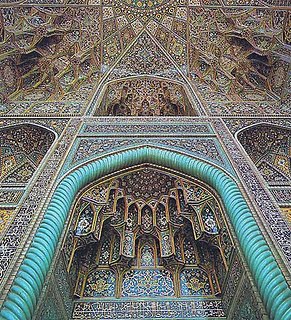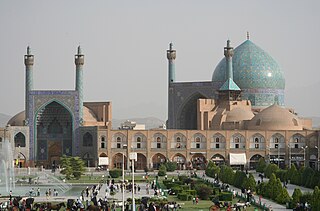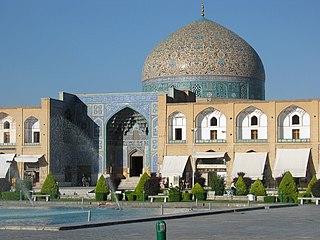
The Qazvin Province is one of the 31 provinces of Iran. It is in the north-west of the country, and its center is the city of Qazvin. The province was created in 1993 out of part of Tehran Province. The counties of Qazvin Province are Qazvin County, Takestan County, Abyek County, Buin Zahra County, Mobarakeh County, Alborz County & Avaj County. The largest cities are Qazvin, Takestan, Abyek, Alvand, Iran, Bidestan, Mobarakeh, Mohammadiyeh & Eqbaliyeh.

Qazvin is the largest city and capital of the Province of Qazvin in Iran. Qazvin was a medieval capital of the Safavid dynasty for over forty years (1555-1598) and nowadays is known as the calligraphy capital of Iran. It is famous for its Baghlava, carpet patterns, poets, political newspaper and Pahlavi influence on its accent. At the 2011 census, its population was 381,598.

Iranian architecture or Persian architecture is the architecture of Iran and parts of the rest of West Asia, the Caucasus and Central Asia. Its history dates back to at least 5,000 BC with characteristic examples distributed over a vast area from Turkey and Iraq to Uzbekistan and Tajikistan, and from the Caucasus to Zanzibar. Persian buildings vary from peasant huts to tea houses and garden, pavilions to "some of the most majestic structures the world has ever seen". In addition to historic gates, palaces, and mosques, the rapid growth of cities such as the capital, Tehran has brought about a wave of demolition and new construction.

Naqsh-e Jahan Square, also known as Meidan Emam, is a square situated at the center of Isfahan, Iran. Constructed between 1598 and 1629, it is now an important historical site, and one of UNESCO's World Heritage Sites. It is 160 metres (520 ft) wide by 560 metres (1,840 ft) long. It is also referred to as Shah Square or Imam Square. The square is surrounded by buildings from the Safavid era. The Shah Mosque is situated on the south side of this square. On the west side is the Ali Qapu Palace. Sheikh Lotf Allah Mosque is situated on the eastern side of this square and at the northern side Qeysarie Gate opens into the Isfahan Grand Bazaar. Today, Namaaz-e Jom'eh is held in the Shah Mosque.

Goharshad Mosque is a former free standing mosque in Mashhad of the Razavi Khorasan Province, Iran, which now serves as one of the prayer halls within the Imam Reza shrine complex.

The arts of Iran are one of the richest art heritages in world history and encompasses many traditional disciplines including architecture, painting, literature, music, weaving, pottery, calligraphy, metalworking and stonemasonry. There is also a very vibrant Iranian modern and contemporary art scene, as well as cinema and photography. For a history of Persian visual art up to the early 20th century, see Persian art, and also Iranian architecture.

The Shah Mosque, also known as New Abbasi Mosque, Royal Mosque, or Imam Mosque after the Iranian Revolution, is a mosque in Isfahan, Iran, standing in south side of Naghsh-e Jahan Square. It was built during the Safavid dynasty, ordered by Abbas I of Persia.

Sheikh Lotfollah Mosque is one of the architectural masterpieces of Iranian architecture that was built during the Safavid Empire, standing on the eastern side of Naghsh-i Jahan Square, Esfahan, Iran. Construction of the mosque started in 1603 and was finished in 1619. It was built by the chief architect Shaykh Bahai, during the reign of Shah Abbas I of Persia. On the advice of Arthur Upham Pope, Reza Shah Pahlavi had the mosque rebuilt and repaired in the 1920s.

The Jāmeh Mosque of Isfahān or Jāme' Mosque of Isfahān is the grand, congregational mosque (Jāmeh) of Isfahān city, within Isfahān Province, Iran. The mosque is the result of continual construction, reconstruction, additions and renovations on the site from around 771 to the end of the 20th century. The Grand Bazaar of Isfahan can be found towards the southwest wing of the mosque. It has been a UNESCO World Heritage Site since 2012.

Safavid art is the art of the Persian Safavid dynasty from 1501 to 1722, in present-day Iran and Caucasia. It was a high point for the art of the book and architecture; and also including ceramics, metal, glass, and gardens. The arts of the Safavid period show a far more unitary development than in any other period of Iranian art. The Safavid Empire was one of the most significant ruling dynasties of Iran. They ruled one of the greatest Persian empires, with artistic accomplishments, since the Muslim conquest of Persia.

The Monar Jonban or Menar-e Jonban, is a monument located in Isfahan, in central Iran. Construction began in the 14th century Safavid or Ilkhanate dynasties of Iran to cover the grave of Sufi Amu Abdollah Soqla. Its notable feature is that if one of the minarets is shaken, the other minaret will shake as well.

Bahāʾ al‐Dīn Muḥammad ibn Ḥusayn al‐ʿĀmilī was an Arab Shia Islamic scholar, philosopher, architect, mathematician, astronomer and poet who lived in the late 16th and early 17th centuries in Safavid Iran. He was born in Baalbek, Ottoman Syria but immigrated in his childhood to Safavid Iran with the rest of his family. He was one of the earliest astronomers in the Islamic world to suggest the possibility of the Earth's movement prior to the spread of the Copernican theory. He is considered one of the main co-founders of Isfahan School of Islamic Philosophy. In later years he became one of the teachers of Mulla Sadra.

The Grand Bazaar is a historical market located in Isfahan, Iran, also known as the Qeysarriyeh Bazaar, Qeysarie bazaar or Soltani bazaar. The main commercial activities in the Qeysarie bazaar are carpet and kilim selling.

Maghsoudbeyk mosque is near the northeastern corner of Naqsh-e Jahan Square. It was built in 1601 by the order of Maghsoudbeyk, who was one of the very rich stewards of Abbas I. There is an inscription in the mihrab of this mosque, which is one of artworks of the famous calligrapher of the Safavid era Ali Reza Abbassi. It's said, after that Shah Abbas was very satisfied with this inscription, he ordered Ali Reza Abbassi to work on the inscriptions of Sheikh Lotfollah Mosque. Behind the entrance hall of the mosque in a small chamber, there's a tomb which is the tomb of Mir Emad, the art rival of Ali Reza Abbassi. Maghsoudbeyk mosque was a very glorious and beautiful mosque in Isfahan in the Safavid era.

Emamzadeh Esmaeil and Isaiah mausoleum is a historical complex in Isfahan, Iran, which dates back to the Seljuk and Safavid era. This complex is located near the Jameh Mosque of Isfahan, in the Hatef street and contains two mausoleums, one believed to be for Esmaeil, one of grandsons of Hasan ibn Ali, and another which is believed to be Isaiah's.

Baba Ghassem mausoleum is a historical mausoleum in Isfahan, Iran. It dates back to the 14th century. It is well known for its beautiful mihrab and dome. It is located to the north of Jameh Mosque of Isfahan. It was repaired and revamped in the Safavid era. Baba Ghassem was one of the prominent faqihs in Isfahan. One of his devotees built the Emamieh school for him, when Baba Ghassem was alive and after Baba Ghassem's death he built this mausoleum for him. The tomb has brick and tile decorations. Its dome is pyramidical. This mausoleum was very respected in the past, so that people swore to it beside the tomb for proving that they are telling the truth. On the below part of the dome of the structure, one of the names of Allah has been written in the Bannai script.

Takht-e Foulad(Persian: تخته فولاد) is a historical cemetery in Isfahan, Iran. The cemetery is at least 800 years old. In the 13th century in the Ilkhanid era Takht-e Foulad was the most important cemetery in Isfahan and all of the famous personalities have a mausoleum in this cemetery. Unfortunately all of the mausoleums from the Ilkhanid era, except Baba Rokn ed-Din mausoleum, which is the oldest structure in Takht-e Foulad, have been destroyed. In the Safavid era there were 400 mausoleums in Takht-e Foulad, but there are now only 8 mausoleums from the Safavid era. In the Qajar era a large part of the cemetery was destroyed, but the cemetery hasn't lost its importance and by the end of Pahlavi era it was the most important cemetery in Isfahan. There are 20 structures from the Qajar era and 17 structures from the Pahlavi era in the cemetery. Before the Safavid age the cemetery had been known as Lessan ol-Arz and Baba Rokn ed-Din, but from the Safavid age until now its name is Takht-e Foulad.

The Khozan mosque is a historical mosque in the Khomeyni Shahr County of the Isfahan Province. The original building of the mosque dated back to the Timurid era in the 15th century, but it's improbable that the current building to be older than the Safavid era. The mosque has four iwans. The southern iwan leads to the inner space of the dome. The inner space of the dome is decorated by muqarnas. The walls of the mosque are covered by stones and bricks. The arches of the northern and southern iwans are decorated with some paintings from the Safavid era., but the paintings of the eastern and western iwans seem to belong to the Qajar era. The shabestan of the mosque is behind the western iwan. There are 20 stone columns with the height of 2 m in the shabestan. The shabestan had been lit originally with the marble stones of the ceiling, but during the recent reparations, these marble stones have been removed.
Mohammad Reza Emami was a Persian calligrapher in the 17th century. He lived from the era of Abbas I until the era of Suleiman I. He was Ali Reza Abbassi's student and was known as the Imam of calligraphers.
















